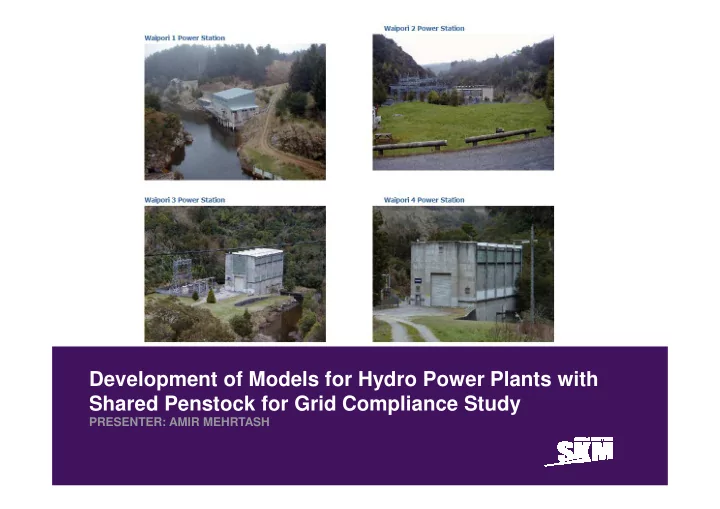

Development of Models for Hydro Power Plants with Shared Penstock for Grid Compliance Study PRESENTER: AMIR MEHRTASH
Contents 1. Introduction 2. Network Model 3. Plant/Frame Model 4. Excitation System Model 5. Prime-Mover/Turbine Model 6. Governor Model 7. Governor/Turbine Tests 8. Conclusion
Introduction • The Waipori River is located about 64 km to the west of Dunedin, rising in the Lammerlaw Mountains. After winding through a course of about 24 km the River emerges into a valley 1.5 km wide and 27 km long, with a drop of only 30-metres. Following the first steps towards generating electricity from the Waipori River in May 1900, on 27th April 1907 the Waipori Hydro-Electric Power Station was commissioned. This hydro scheme consists of four generation stations as follows: • Station 1A (separate penstock): Unit G1A: 12.88 MVA, 0.75pf. • Station 2A (shared penstock): – Unit G2A-1: 23.00MVA, 0.91 – Unit G2A-2: 26.15MVA, 0.90pf – Unit G2A-3: 26.15MVA, 0.69pf • Station 3 (separate penstock): Unit G3: 8.0MVA, 0.80pf. • Station 4 (separate penstock): Unit G4: 9.0MVA, 0.80pf.
Network Model (DIgSILENT)
Plant/Frame Model: Separate Penstock w(1) qg pg curgn fe curex u 0 1 2 3 ve vco slot 0 4 upss ElmVco* 1 0 5 2 6 3 1 a 7 pss slot Pg 4 a 8 ElmPss* 5 2 b 6 0 b 7 3 c 1 c 8 0 2 3 u1r:bus1 xmdm 1 4 u1i:bus1 5 cur1r 2 6 cur1i 7 psie a 3 8 9 pt b 4 10 dw 0 0 0 11 sym Slot fe 1 c 5 12 ElmSym* bladepos 2 1 1 13 (.. pmu Slot gatepos n gn psco 3 2 2 ElmPmu* d 6 14 s rvp pturb 4 3 3 15 5 4 c e 7 16 6 17 b c 7 5 d f 8 18 c pcu Slot 0 y1 d 8 ElmPcu* 6 e 19 d 1 e 9 7 f g 9 Input file 2 y3 f 10 8 g 20 20 e ElmFile* 3 y4 g 11 h 10 22 g w(2) 4 y5 h 12 9 h 23 h fe_inj 13 xmt cosn sgnn w pgt pgt(1.. xme
Plant/Frame Model: Common Penstock
Excitation System Model(Standard SEXS Model)
Turbine and Penstock Model – Single Penstock
Nonlinear Model of Multiple Penstocks and Turbines Supplied from Common Tunnel [Ref1]
Turbine Model – Common Penstock
Penstock Model – Common Penstock
Penstock Time Constant (Water Starting Time Constant) • Constant diameter penstocks: × Q L = T w × × g H A where Q is the maximum flow rate (m 3 /s), H is the head (m), L is length of penstock (m), A is penstock area (m 2 ), and g =9.8m/s 2 is the gravity constant . • Varying diameter penstocks: Q n L ∑ = T i w × g H A = 1 i i Q H L A T w Station ( m 3 /s ) ( m 2) (m) (m) (s) 1A 42 27 173.7 10.18 2.71 2A 37 223.5 650 3.1 3.57 (Common Section) 2A-1/2A-2 37 223.5 50 3.1 0.27 (Individual Section) 2A-3 37 223.5 125 1.86 1.13 (Individual Section) 3 19 50.57 88.5 4.1 0.83 4 19 57.3 108 4.1 0.9
Governor Model
Governor/Turbine Tests • 1.1. On-line Frequency Step Test (Unit G2A-1)
Governor/Turbine Tests • 1.2. On-line Frequency Step Test (Unit G3)
Governor/Turbine Tests • 1.3. On-line Frequency Step Test (Unit G4)
Governor/Turbine Tests • 2.1. Governor Stability (Station 2A): As-left PID Parameters as-left PID parameters: Kp=2 and Ki=0.14
Governor/Turbine Tests • 2.1. Governor Stability (Station 2A): Modified PID Parameters modified PID parameters: Kp=0.5 and Ki=0.01
Governor/Turbine Tests • 2.2. Governor Stability (Station 3): As-left PID Parameters
Governor/Turbine Tests • 2.3. Governor Stability (Station 4): As-left PID Parameters
Conclusion • The Governor/Turbine model is capable of predicting the plants’ behaviour during frequency excursions (for the stations 2A, 3 and 4). • The DIgSILENT model implemented (using the as-left parameters) for station 2A predicts sustained oscillatory behavior (not unstable) after a small step change in resistive load (all units operating at 80% load whilst isolated from the grid). It can be rectified by adjusting the PID parameters. • The plant model implemented (using the as-left PID parameters) for stations 3 and 4 predicts stable and damped behaviour at entire range of active output power (whilst isolated from the grid)
References 1) “ Hydraulic Turbine and Turbine Control Models for System Dynamic Studies ”, IEEE Working Group on Prime Mover and Energy Supply Models for System Dynamic Performance Studies, IEEE Transactions on Power Systems, vol. 7, No.1, Feb 1992. 2) “ Electricity Industry Participation Code ”, Electricity Authority, New Zealand: http://www.ea.govt.nz/act-code-regs/code-regs/the-code/ 3) “ Waipori 3 Power Station, Unit No. 1 - Governor Replacement Commissioning “, Contech Services Ltd report dated November 2008. 4) “ Waipori 4 Power Station, Unit No. 1 - Governor Replacement Commissioning “, Contech Services Ltd report dated February 2009.
Thank You ANY QUERIES: AMEHRTASH@GLOBALSKM.COM v www.globalskm.com www.globalskm.com
Recommend
More recommend